

Informed Consent Agreement and Beneficiary Agreement - The Genetic Genealogist. Last year in the Facebook group Genetic Genealogy Tips & Techniques, we were discussing the need in the community for an informed consent agreement and a beneficiary designation form.
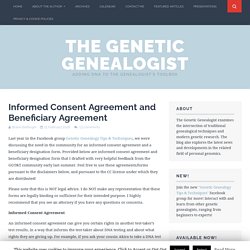
Provided below are informed consent agreement and beneficiary designation form that I drafted with very helpful feedback from the GGT&T community early last summer. Feel free to use these agreements/forms pursuant to the disclaimers below, and pursuant to the CC license under which they are distributed! Leeds Method: Why Do I Have More Than 4 Clusters? Or, Time to Consolidate! - Dana Leeds.
The Question Today I want to discuss one of the most frequent questions I get: Why did I get more than 4 color clusters on my Leeds Method chart?
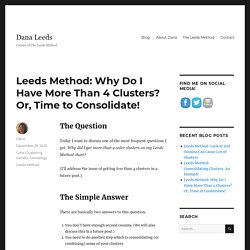
(I’ll address the issue of getting less than 4 clusters in a future post.) The Simple Answer. DNA links 5,500 year old remains of aboriginal woman found in Canada and her 200 x great-grandaughter who still lives nearby. Scientists have traced a genetic descent from the 5,500 year-old remains to a second set of 2,500 year-old female remains found nearby and, amazingly, to a woman still living close to both prehistoric sites on British Columbia’s northern coast.

The study used DNA samples from 60 modern members of the indigenous Tsimshian, Haida and Nisga’a tribes from the Metlakatla First Nation. The samples were compared with mitochondrial DNA extracted from the teeth of four ancient people: two skeletons aged 6,000 years and 5,500 years unearthed in an ancient shell midden on Lucy Island, and two skeletons aged 5,000 years and 2,500 years found on Dodge Island. Three living individuals had DNA matches with the older Dodge Island skeleton, and three of the skeletons matched at least one living person.
The oldest Lucy Island skeleton didn’t match any living relatives, but did match a 10,300-year-old skeleton previously unearthed on Prince of Wales Island, Alaska. Sources: Live Science and Canada.com. The Leeds Method with Ancestry.com's Colored Dots - Dana Leeds. Yesterday I watched a YouTube video by Larry Jones of DNA Family Trees called “How to Cluster Your DNA Matches With Ancestry’s New DNA Matches Beta.”
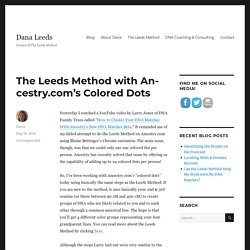
It reminded me of my failed attempt to do the Leeds Method on Ancestry.com using Blaine Bettinger’s Chrome extension. The main issue, though, was that we could only use one colored dot per person. Ancestry has recently solved that issue by offering us the capability of adding up to 24 colored dots per person! So, I’ve been working with Ancestry.com’s “colored dots” today using basically the same steps as the Leeds Method. Why Your Latest Results Could Include More Scotland In Your Ethnicity Estimates. Our 2020 ethnicity update is the first time we are dividing results in the UK and Ireland into four populations instead of two.

Over the years, the names of our ethnicity regions for the UK and Ireland have changed, but we’ve always had only two regions to compare customers’ DNA against, roughly an Ireland/Celtic/Gaelic group and an Anglo-Saxon/Britain/England group. Now we have four: England & Northwestern Europe, Ireland, Scotland, and Wales. Now because I am on the science team, I knew that my England & Northwestern Europe would probably go down and my Scotland would go up. Our vast, shared family tree. You might not like to admit it, but you’re related to me.
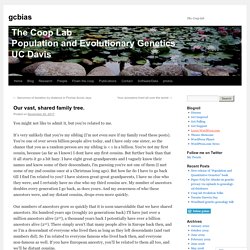
It’s very unlikely that you’re my sibling (I’m not even sure if my family read these posts). You’re one of over seven billion people alive today, and I have only one sister, so the chance that you as a random person are my sibling is < 1 in a billion. Legacy Family Tree Webinars : Membership Area. Why Your Latest Results Could Include More Scotland In Your Ethnicity Estimates - Ancestry Blog. Our 2020 ethnicity update is the first time we are dividing results in the UK and Ireland into four populations instead of two.
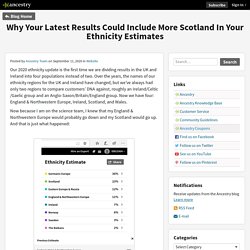
Over the years, the names of our ethnicity regions for the UK and Ireland have changed, but we’ve always had only two regions to compare customers’ DNA against, roughly an Ireland/Celtic/Gaelic group and an Anglo-Saxon/Britain/England group. Now we have four: England & Northwestern Europe, Ireland, Scotland, and Wales. Now because I am on the science team, I knew that my England & Northwestern Europe would probably go down and my Scotland would go up.
The 3 Loudest Bluetooth Speakers For Blasting Summer Tunes. Smaller speakers tend to mean smaller sound, but not always.

There are also super-sized speakers that can blow the roof off with their volume, but you’ll likely hurt your back just moving them even a few inches. Lately, I’ve been interested in speakers that give you the best of all possible worlds: Bluetooth-connected so you can play your music easily from your phone or tablet, for instance, light enough to be carried without risk of a hernia, loud enough to get the party started and with enough battery life to keep going right to the end. The DNA database used to find the Golden State Killer is a national security leak waiting to happen. Razib Khan, a genomics researcher who is head of scientific content at Insitome, a service that interprets DNA for consumers, called the new security research a large-scale demonstration of weaknesses already known to enthusiasts.

Khan says he has been aware of efforts to “scrape” GEDmatch, or collect more data than usual, and believes a larger attack to whisk away much of the data could already have occurred. “My guess is that almost certainly it’s already been done,” he says. “Governments are collecting data on people. You never know what they can use it for.” Asked if there was evidence the database had already faced concerted attacks, scraping, or scanning, Rogers said, “I don’t want to get into it.” DNA Color Clustering: The Leeds Method for Easily Visualizing Matches - Dana Leeds. Unsure of how other people were sorting their Shared Matches from AncestryDNA, I developed my own method: the Leeds Method of DNA Color Clustering.

This simple and quick method helps you easily visualize how your close cousins are related to you and each other. I created this method while working with an adoptee, and it works wonderfully for unknown parentage cases where the cousins are strangers and their true relationships are unknown. It also works wonderfully with traditional genealogy. In fact, it is being used to break down some more recent brick walls! DNA Color Clustering: The Method. How the X-Chromosome Solved an Adoption Mystery. HANDOUT DNA Painter CORRECTED. Do the Irish have Viking DNA? Yes, the Irish have Viking DNA. iStock Yes, the Irish do have Viking DNA and are also more prone to certain diseases, DNA tests show. A new “DNA map” of the Emerald Isle reveals that the Viking raiders intermingled with local women far more than was previously thought.
Genealogist Gianpiero Cavalleri of the Royal College of Surgeons pieced together a detailed map after studying the DNA of over 500 Irishmen and women. Read More: First genetic map of the people of Ireland “Plenty of clues already showed that Vikings had been to Ireland, including ruins, artifacts, and Norwegian family names… The [genetic] signatures that turned up in Ireland are most similar to those from the north and west coasts of Norway, where Vikings were most active,” Cavalleri told National Geographic.
The Vikings from the Scandinavian countries began raiding Ireland around 800 A.D. and continued for two centuries before Brian Boru defeated them at the Battle of Clontarf in 1014. DNA Source Citations – Family Locket. Are you ever frustrated while writing citations? Many people are! Learning about a simplified formula for citations can lift the frustration and bring calm to an important part of genealogical research. DNA Gedcom – A 3rd Party Tool That Can Help Shorten Your Search – Family Locket. What if you could find an automated program that would help you… – Look through your DNA matches trees to find shared ancestors – Identify triangulated groups, and.
Scotland’s genetic landscape echoes Dark Ages. The DNA of Scottish people still contains signs of the country’s ancient kingdoms, with many apparently living in the same areas as their ancestors did more than a millennium ago. Experts have constructed Scotland’s first comprehensive genetic map, which reveals that the country is divided into six main clusters of genetically similar individuals: the Borders, the south-west, the north-east, the Hebrides, Orkney and Shetland.
Genetic continuity These groupings are in similar locations to Dark Age kingdoms such as Strathclyde in the south-west, Pictland in the north-east, and Gododdin in the south-east. The Dark Ages are widely considered to be from the end of the Roman Empire in 476 AD to around 1000 AD. In addition to showcasing Scotland’s genetic continuity, experts believe this type of population analysis could aid the discovery of rare DNA differences that might play major roles in human disease. The Best Free DNA Genealogy Websites. You’ve had your DNA tested with a genetic genealogy company (maybe even more than one), you’ve reviewed your ethnicity estimate and you’ve gone through your match list. Now what should you do? How do you maximize your testing dollars to wring every bit of useful genealogical information out of your DNA test(s)? The answer may be in tools at third-party websites—so, not the sites of companies offering DNA testing—which give you new ways to analyze your test results.
That can lead you to revelations about your family tree. Tips for Using GEDmatch - Genie1. Gedmatch Genesis Tutorial for Beginners - Who are You Made Of? Time to move to GENESIS! At my recent GEDmatch talk for i4GG, I warned the crowd that soon Genesis would be the only place at GEDmatch where you could upload new DNA kits. Control Panel. AncestryDNA Matches color coding, How to get around the 24 color limit! How to Cluster your DNA matches With Ancestry's New DNA Matches Beta. Ancestrydna match triangulation to find or prove your family tree. The Death Of The Family Secret. On a punishingly hot afternoon last June, Ali Cole stepped into Philadelphia’s elegant, French Renaissance Revival Bellevue Hotel carrying Father’s Day gifts for a man she didn’t know existed two months earlier ― her biological father, who was not the man who had raised her. Until last spring, Ali had no reason to question whether the man she grew up believing was her father really was.
And to make matters even stranger, her friend Jess McIntosh had been through something similar just six months before that, when an email from Ancestry.com landed in her inbox naming the man who had donated sperm to her mother more than three decades ago. Neither woman had set out to find her father. 10 Ways to Group Your DNA Matches into Genetic Networks – Family Locket. A great way to get the most out of the list of your DNA matches is to separate the people into groups that cluster around one of your ancestral lines. If you can divide your match list into groups, you can focus on finding the most recent common ancestor (MRCA) that you share with that cluster of people. Once that common ancestor or ancestral couple is identified, you can focus your research on one familial line, and identify the DNA that you inherited from the common ancestor(s).
The groups of related people are sometimes called “Clusters” or “Genetic Networks.” Promethease. Family Vault. DNA.LAND. Introducing The Theory of Family Relativity™ — a Genealogy Game-Changer - MyHeritage Blog. We’re excited to introduce a new feature, which is a total game-changer in genetic genealogy — the Theory of Family Relativity™. Up to 40 Percent of Consumer DNA Tests Are Inaccurate. Exclusive: The FBI Had Already Accessed Family Tree DNA’s Database Before Cooperation. The conundrum for the company: What to do? How to respond? FamilyTree’s legal analysis indicated the FBI had probable cause, by the sheer numbers. That was proven mathematically by a study in Science in November 2018, which showed that the scope of current DNA databases can identify 60 percent of Americans of European ancestry.
Quick Tip: Shared Matches at AncestryDNA – The DNA Geek. Inside the genetic genealogy being used to solve crimes. Using Filters to Focus on One Family at a Time. Testing Artifacts to Obtain DNA Evidence for Genealogical Research - The Genetic Genealogist. Artifact testing promises to be an interesting component of the future DNA evidence and genealogy. If we can obtain and reliably identify DNA from deceased ancestors, relatives, or other individuals, we might be able to enrich our genealogical research. DNA Color Clustering: The Leeds Method for Easily Visualizing Matches - DanaLeeds.com. Building Quick & Dirty Trees to Identify Genetic Matches. My Adoption Story. I always knew I was adopted. When the DNA says your parents are related. Solving an Adoptee Case with DNA Networks and Mind Mapping – Family Locket.
PARTNERSHIP: FindMyPast & LivingDNA. New Filtering System for DNA Matches « MyHeritage Blog. FTDNA Project Member Privacy Settings – Quick Start Guide. Introducing the Health Family Tree « MyHeritage Blog. Irish Ancestry Surprises Revealed by New DNA Map. DNA Testing Balancing Value and Privacy. Walking Where Ancestors Walked: Travelers Give High Marks to First Genealogy Tour.
How to Preserve and Test Old Letters for Grandma’s DNA. Viking invasions made a lasting impression on Irish DNA. Map segments to ancestors. Stevens/Orr Family Site (BackupMyTree) DNA.LAND. Promethease. Sign In · Living DNA. AK'S Genealogy Research: Resolving A Brickwall with Maps/ Why DNA Segment Data is Important. Introducing the DNA Match Review Page « MyHeritage Blog. Living DNA updates and GEDmatch Genesis. Introducing the DNA Match Review Page « MyHeritage Blog. DNA Matching Now Live. More Than a Pie Chart and a Number: Reading Your Ethnicity Estimate – Ancestry Blog. Scientists Say Your Eye Color Reveals Information About Your Personality. Mine Was SO TRUE! Will Humans Eventually All Look Like Brazilians? Future - The polygamous town facing genetic disaster. Unlocking the Genealogical Secrets of the X Chromosome – The Genetic Genealogist. DNA Solutions: Working with No-Tree DNA Matches. Cruwys news: AncestryDNA's new Genetic Communities have arrived. Whence the DNA differences?
Unleashed power of DNA. Using GEDmatch tag groups. X Chromosome Inheritance. Using GEDmatch tag groups. Who’s More Irish, You or Your Sibling? The Surprising Science Behind the Inheritance of Ethnicity – Ancestry Blog. Autosomal DNA testing comparison chart - ISOGG Wiki. Log In - New York Times. DNAeXplained – Genetic Genealogy. Genetics show many Scots are descended from Russian nomads.
Latest Developments in Y-DNA (John Cleary) DNA Matching Now Live. 3 Tips for Choosing a DNA Relative to Test. Scientists find clue to why mitochondrial DNA comes only from mom. Beware The Sale of Your DNA – Just Because You Can Upload Doesn’t Mean You Should. MyHeritage is Adding Free DNA Matching. A man’s discovery of bones under his pub could forever change what we know about the Irish.
DNA.LAND. YP355. Scottish DNA - DNA Results. Kitty Cooper's Blog. The Porcupine Chart. YP355 full branching tree with private SNPs. DNA Analysis Shows That Native American Genealogy Is One of the Most Unique in the World. DNA links 5,500 year old remains of aboriginal woman found in Canada and her 200 x great-grandaughter who still lives nearby. New AncestryDNA Common Matches Tool: Love It!
Yahoo! Groups. The Real History of White People. Y-chromosomal Adam suddenly got much older - Abroad in the Yard. X-DNA's helpful inheritance patterns.